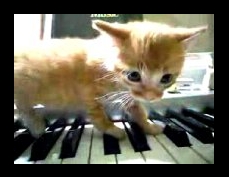The Major Third is probably the most popular interval in America. Every time you walk into a convenience store, it plays for you.
The Major Third is what makes things Major. In the above example, the E is the Major Third of the C – the Tonic. There is an inherently happy quality to this interval. Babies love it, more than sad-sounding Minor Thirds. Why is this so? Because every tone that you hear, has secret overtones embedded in its timbre. These overtones form a scale known as the Harmonic Series.
If a piano plays a single C, then all of these other overtones, or harmonics, will color the sound of this C, letting you know that a piano is being struck, even if you can’t see the sound source. The Harmonic Series explains why we find certain harmonies consonant and others dissonant. Intervals and chords formed from the lowest overtones will result in sounds that are considered “consonant”. The higher overtones will produce harmonies that are considered “dissonant.” The Major Third is the 4th harmonic in the Series. This is why the convenience store ding sounds happy.
Another ubiquitous use of the Major Third is found in car horns. There is some ambiguity in the example below. The real interval is actually between a Major and a Minor Third, but it sounds happy enough. A car is also in motion, so the doppler shift will bend the pitch down as it passes.
It’s possible a pleasing interval was chosen for the car horn, to help sooth the savage motorist’s road-rage. Honking produces a happy interval, so it is probably more the volume of these car chords that make them come off as noisy rather than musical.
The popularity of the Major Third is due to one song – Wesminster Quarters – the bell song that tintinabulates twelve times a day. The Major Third marks the passing of each hour.
Though the Major Third is a happy interval, too much of a good thing can be bad. When you stack two Major Thirds on top of each other, you get this very evil sounding chord, known as an Augmented Chord.
Evil aye? The augmented chord leaves you dying on the side of a mountain. (For more, see the Pi Tone.)
What happens when you combine a Major and a Minor Third into one chord? You get the Hendrix Chord! The Hendrix chord is found in the Modern classical period, blues, and jazz, but Jimi ripped the shit out of this chord. Some chords need to be played on guitar.
You can hear this chord used in Purple Haze.
Bonus Trivia: A misheard lyric, as in “Excuse me, while I kiss this guy” is called a mondegreen.
So there you have it. Major Thirds are the Happy Interval. But too many of them leads to Evil. Combine a Happy Major Third with a Sad Minor Third, and you get Rocked hard.

I’m on da green.



